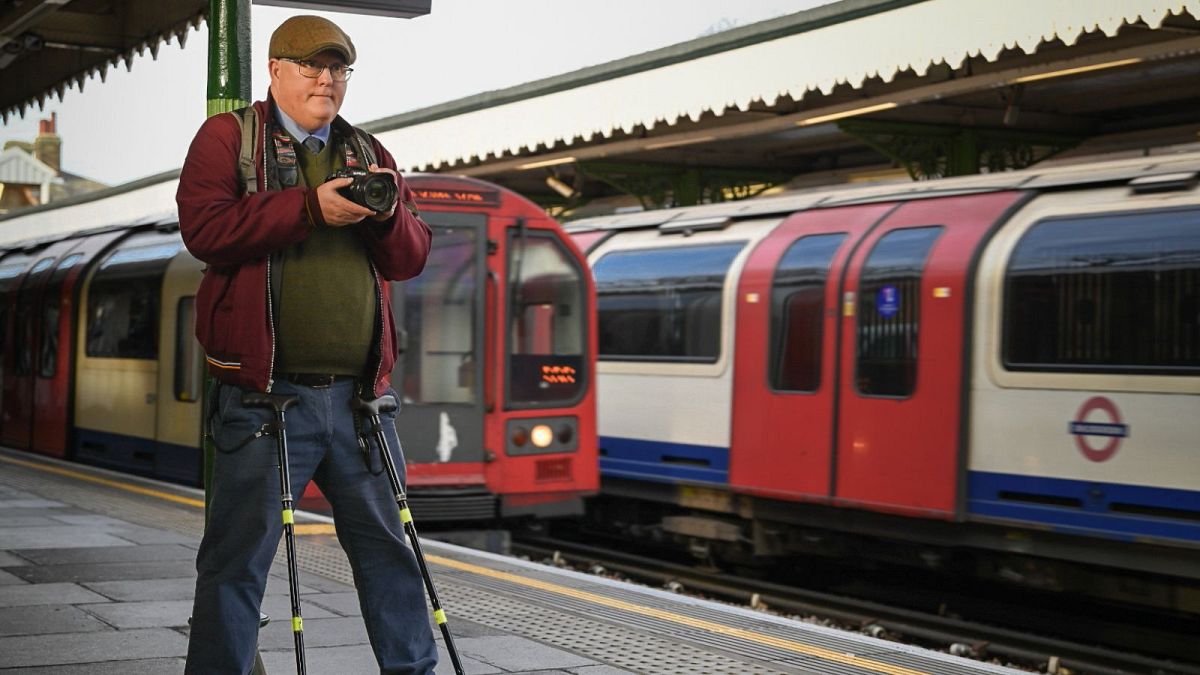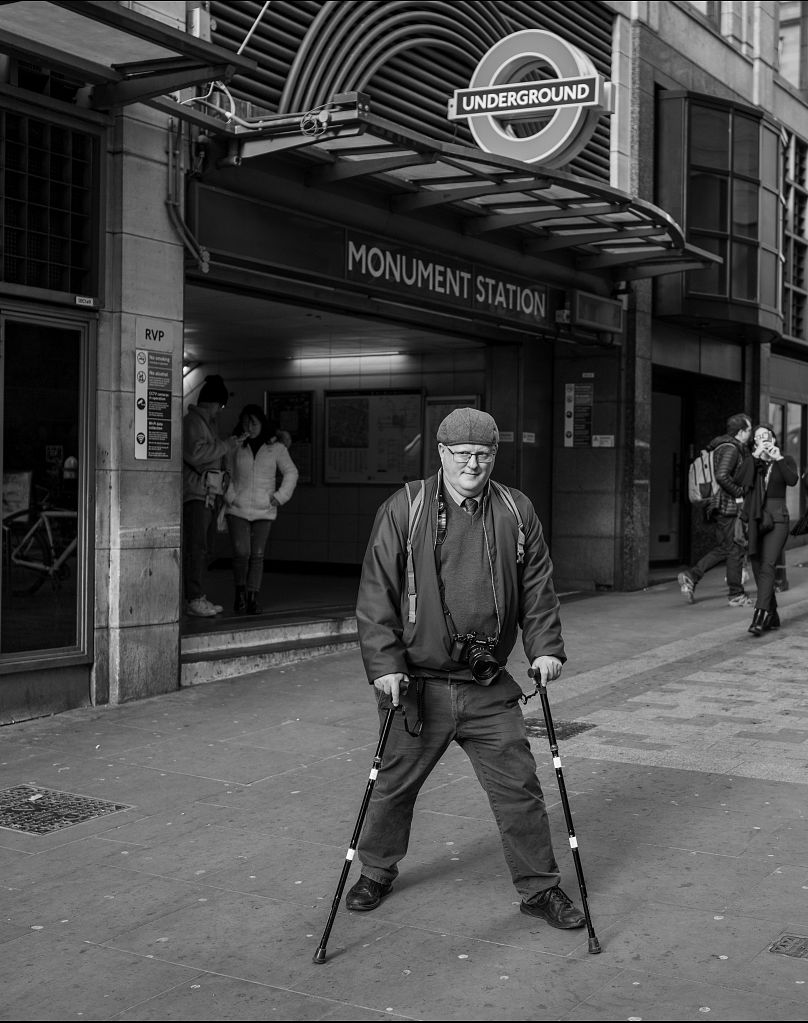Travelling on the tube with ataxia is like 'navigating in 3D', says a photographer who is capturing the beauty in each station.
A man is travelling through all 272 London tube stations to raise awareness about his rare neurological condition and spotlight mobility issues on the network.
Like any proud Londoner, Ben Spencer (49) has always loved to ride the underground. “But it was a utilitarian thing before I started the challenge,” he says. “Now it's a thing that I see in beauty; I’m taking photos, I’m looking at the details and getting involved with the history.”
The challenge that he began on 20 September is coming to an end this Saturday 11 February, with Tottenham Court Road the finishing line.
Others have done it faster; the current record is under 16 hours - though two more stations have been added since it was set in 2015 (and the holders did not enter and exit every stop).
But Ben is on a bigger journey to document his experience with ataxia: a group of neurological disorders that affect people’s balance, coordination and speech. The progressive cerebellar ataxia Ben was diagnosed with last year means the Essex local will soon need a wheelchair.
His photos, which lovingly capture the stations’ idiosyncrasies, have won him thousands of supporters on Instagram and Twitter, where he is known as ‘Tube Snapper’.
Travelling the capital with ataxia is like ‘navigating London in 3D’
Most of us commute back and forth along the same line or two, deferring to the wisdom of the Citymapper app for unfamiliar journeys.
Becoming disabled, Ben found that “you have to get very creative trying to get from A to B, so you start using routes that aren’t suggested by TfL [Transport for London].” A route with one less walk or a flight of steps is preferable when you’re using two sticks to support yourself.
“I now think of it as navigating London in 3D,” he tells Euronews Travel.
Getting from his home in Buckhurst Hill to King’s Cross, for example: he catches the Central Line to Stratford, walks across the platform onto the Elizabeth Line and gets off at Farringdon. A carefully lined up lift - “that nobody really knows about” - goes up to the westbound Barbican platform, putting him in pole position to get off at King’s Cross and be right near the exit.
“So I was able to calculate by doing three or four different loops that I could get there with probably only taking about 100 steps.”
Akin to the famous ‘Knowledge’ of London taxi drivers, it’s clear that the Tube Snapper has built up a detailed mental picture of the subterranean network.
But could TfL be making it easier for people with mixed abilities?
How could accessibility be improved on the London Underground?
Though there are tube maps showing which stations are step free, Ben wants to see a more cohesive website or app for ambulatory wheelchair users who can walk to an extent.
Ideally it would also illustrate which interchanges (the passages between different tube lines) are step free.
Different stations vary considerably in terms of how well equipped they are for less able-bodied people. Only 92 (around a third) of tube stops are step free and, says Ben, “a lot of the time you’ll get somewhere and the lift will be broken.”
The TfL Access Twitter account does a “good job” at providing updates on lift maintenance. But longer-term issues are noted elsewhere on the TfL website and can be hard to find.
Some days will just be harder than others. Ben has built this into the logistics of his 272-station challenge.
“Because my condition is progressive and degenerative I knew it would be easier at the start than at the finish. I started by trying to do more stations a day and doing the ones that were the hardest in terms of accessibility,” he says.
“I saved the local ones for days where I could still go out but I was extremely tired and could only do an hour or so.”
Ben’s unique tube challenge has “totally” changed his relationship with the underground, he adds. Even his favourite station.
“I really really loved Sudbury Town. It’s a very popular station for anyone who likes the underground,” he says, down to its unusual architecture and history.
But an old-fashioned and peaceful pit stop has taken its place. “I've actually sort of fallen in love with the least used station on the underground, which is Roding Valley.”
How helpful are people on the Tube?
Some days are also tougher than others due to Ben’s fellow passengers. At the beginning, he kept stats about whether or not people offered him a seat on the tube.
“I noticed that people's attitude towards you changes depending on whether it's rush hour or not,” he says. “In rush hour, 50 per cent of the time I would have to speak very loudly and ask for a seat.
“And there were times when people were like ‘Why are you travelling if you’re disabled in rush hour?…’ They didn’t say that, but that's the look on their face. And you can tell they’re just miffed that they have to give up their seat and they don't want to, because their day has been long and tiring, and that can be really off-putting.”
The way crowds behave on the platform is another problem. “People will see the sticks, but they’ll walk straight at you, or get in front of you, and won't give you any space. For somebody with balance issues, that can be really scary.”
“I've been attacked a couple of times on the underground; groups of kids who have pulled my hat off and called me names and things like that," Ben adds. "I managed to raise my voice and get my stuff back.
“Really it’s a microcosm of what people with disabilities face.”
Yet the negative stuff is “vastly outweighed” by the positive interactions, he says.
People will frequently offer to help him up stairs, make space when he’s getting on and off the carriage, and immediately give up their seat.
“One thing I would say categorically that is just 100 per cent amazing - considering how short staffed they can be sometimes - is every single member of the staff that I’ve spoken to has been absolutely lovely.”
Some drivers will toot in encouragement if they see him, and one TfL worker has even arranged an official visit for Ben to a signal box on the Metropolitan Line.
Then there’s the close-knit group of tube and train enthusiasts who have uplifted the Tube Snapper on his mission. “As a community, I found a bunch of friends who I think I'll be friends with for life,” he says.
What support is available for people with ataxia?
Asking for help has not always come easily to Ben, an ex bouncer and Millwall Football Club supporter from South London. But it’s one of his top tips for people diagnosed with ataxia, alongside engaging with the community.
Less than 100,000 people in Europe have ataxia, according to euro-Ataxia, a nonprofit that connects national charities. A lack of awareness about the disease means diagnoses and help often come late.
Ben first experienced problems with walking, coordination, speech and balance a decade ago, and has had intentional tremor episodes for 20 years. A neurologist misdiagnosed him with essential tremor (a different neurological disorder) 15 years ago.
“There is so much help that can be given to somebody with ataxia that vastly improves the quality of their life, but they can't be given that help until they've been diagnosed.”
Ataxia UK offers speech therapy and a voice banking service, for example. Ataxia & Me, a nonprofit run by patients, has been a great support on his journey also.
“The Tube Challenge has physically kept me going,” Ben says. “Without it, I would almost certainly be in a wheelchair all the time now, because one of the things with ataxia is that if you’re not constantly exercising, you lose the ability to use those muscles.
“The mental side of things is really tough,” he adds. “Without the people I've met on the tube, especially the tube staff, without [the charities], I think I would be really not in a good place.”
What’s next after the Tube Challenge?
Completing the Tube Challenge this weekend is not the end of Ben’s travel adventures and wider campaign for accessibility.
He expects to be using a wheelchair permanently by the end of 2023, and “the next thing I really want to push is how inaccessible the tube is and why we need to change it.
“So this challenge has only really been part one of my journey. Part two is going to be going round all the stations that I can, in my wheelchair.” The photos will continue, likely with a new system of green ticks and red crosses to “really hammer home the message that it's not acceptable.”
Running alongside and underneath this mission is a deep and abiding love of the underground.
An endless curiosity with “those little details and those stimulations and that love of tube stations that I found and the people who work there. It's just been amazing.”




